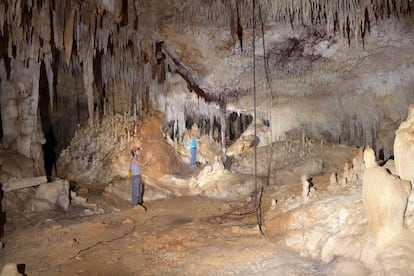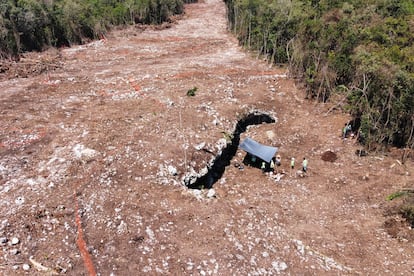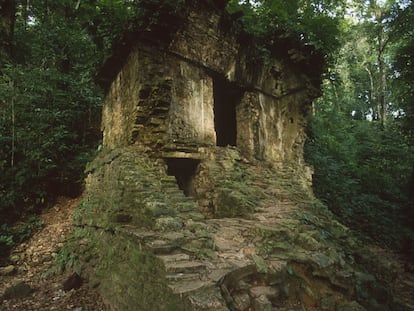‘Angry Wasp’: Mexico’s Maya Train accused of jeopardizing vital cave systems
Work to build the project has already uncovered the entrance to ‘Angry Wasp’ a cavern that is nearly two miles long and home to bats, toh birds and blind brotula fish

The scientists raised the alarm more than a month ago: a change in the route of Mexico’s Tren Maya, or Maya Train, between Cancún and Tulum would threaten karstic ground full of caverns, cenotes and underground rivers, which account for the main reserve of fresh water in the region. Last week, logging in the jungle to clear a path for the train at Playa del Carmen, in Quintana Roo, has confirmed these fears. The work has uncovered the main entrance to the “Avispa enojada,” or Angry
, a cave nearly two miles long (three kilometers) in which bats, toh birds and blind brotula fish live. The jaguar depends on caves like this one to drink water in the dry seasons, but the future of the natural phenomenon is now under threat: to support the weight of the train, supports would have to be built inside or they will have to be completely filled in. The authorities, for now, have not made their plans public.
“We have been saying this since the start to Fonatur, but they didn’t listen to us and these are the results,” complains biologist Roberto Rojo, from the civic association Círculo Espeleológico (Cavers Circle), referring to the authority in charge of the work.
For more than 20 years, Rojo has been exploring the complex underground world in this area of the peninsula in Yucatán, of which there is much left to discover. From the outside, you can see the enormous stalactites that hang from the roof of the cave, which are several meters across. Once inside, Rojo explains, the cavern is decorated with “beautiful formations” that have been created over a space of two million years, as the water dissolves the limestone rock of which they are made. Inside, as in so many other caves in the area, archeological vestiges have also been found.

During his morning press conference, Mexican President Andrés Manuel López Obrador stated that the work would not affect these cave systems. “The project includes building viaducts that will pass over the top, they will not be touched, the subterranean rivers and the cenotes will not be affected,” he said on Tuesday. The scientists and environmentalists who have organized a campaign against the train’s route through the jungle doubt that this will be possible. Around 500 meters from the Angry Wasp, also under the deforested zone to build the tracks, there is another enormous cave that’s 1.24 miles (two kilometers) long, known as “Alita.” On Wednesday afternoon, once the train workers had gone, speleologist Tanía Ramírez rappelled down the entrance to the cavern. “There were enormous chambers, and the most interesting thing was that on the way out we found a prehispanic stairway,” she explains.
“I feel very sad and powerless,” Ramírez complains. “These are places that we have been exploring for years, we know this jungle perfectly well and it’s so sad that they want to shut us up in this way, that they want to cover up the sun with a finger and that they insist that there are no caves there, that this is attack politics, when that’s really not the case.”
Given the rejection of experts, environmentalists and even celebrities, the new train route through the jungle, the so-called 4T, has mobilized defenders of the project, who have classified those who have raised their voices in protest as “pseudo-environmentalists.” On Thursday, the president made a video public in which inhabitants of the Jacinto Pat area, through which the train will pass, show their support for the project.

“We noted that the agencies are doing the studies of the ground, flora and fauna, and there isn’t the ecocide that they say there is,” says Tony Kinil, an inhabitant of the area, in the video. The president of the local authority, Cresencio Noh, claims that the tracks will pass three kilometers “behind” the Dos Ojos cenote, in the jungle, “where, without a doubt, they will not affect us.”
Until now, Fonatur has not made public the official path of route 5 of the Maya Tren, but the deforestation work started at the end of February, shortly after they announced that the tracks would not run next to the road that connects Cancún and Tulum, as was initially planned. The opposition of the hotels, which had to cede part of the entrance to their luxury resorts, and the time it took to present the work – which included raising the tracks over the Playa del Carmen beach – worked against the original plan.
On February 6, shortly before the machines arrived at the beach, the industrial engineer Guillermo D. Christy and other members of the Cenotes Urbanos collective, discovered a pristine cave that had never been explored. They called it “Yorgana 3.” They took several weeks to map it out and record the different species that lived there, including Yucatecan frogs, blind brotula fish and coral shrimp. From the ground to the ceiling there were less than two meters. Now the entrance has been exposed, after workers cleared the jungle that covered it. “How is the cabling of a train going to pass through there?” they ask. “The ceiling won’t hold. They’ll have to fill it or blow it up. Either option is terrible, because they are endangering species that are at risk of extinction.”
Tu suscripción se está usando en otro dispositivo
¿Quieres añadir otro usuario a tu suscripción?
Si continúas leyendo en este dispositivo, no se podrá leer en el otro.
FlechaTu suscripción se está usando en otro dispositivo y solo puedes acceder a EL PAÍS desde un dispositivo a la vez.
Si quieres compartir tu cuenta, cambia tu suscripción a la modalidad Premium, así podrás añadir otro usuario. Cada uno accederá con su propia cuenta de email, lo que os permitirá personalizar vuestra experiencia en EL PAÍS.
¿Tienes una suscripción de empresa? Accede aquí para contratar más cuentas.
En el caso de no saber quién está usando tu cuenta, te recomendamos cambiar tu contraseña aquí.
Si decides continuar compartiendo tu cuenta, este mensaje se mostrará en tu dispositivo y en el de la otra persona que está usando tu cuenta de forma indefinida, afectando a tu experiencia de lectura. Puedes consultar aquí los términos y condiciones de la suscripción digital.
More information
Últimas noticias
Most viewed
- Sinaloa Cartel war is taking its toll on Los Chapitos
- Oona Chaplin: ‘I told James Cameron that I was living in a treehouse and starting a permaculture project with a friend’
- Reinhard Genzel, Nobel laureate in physics: ‘One-minute videos will never give you the truth’
- Why the price of coffee has skyrocketed: from Brazilian plantations to specialty coffee houses
- Silver prices are going crazy: This is what’s fueling the rally











































